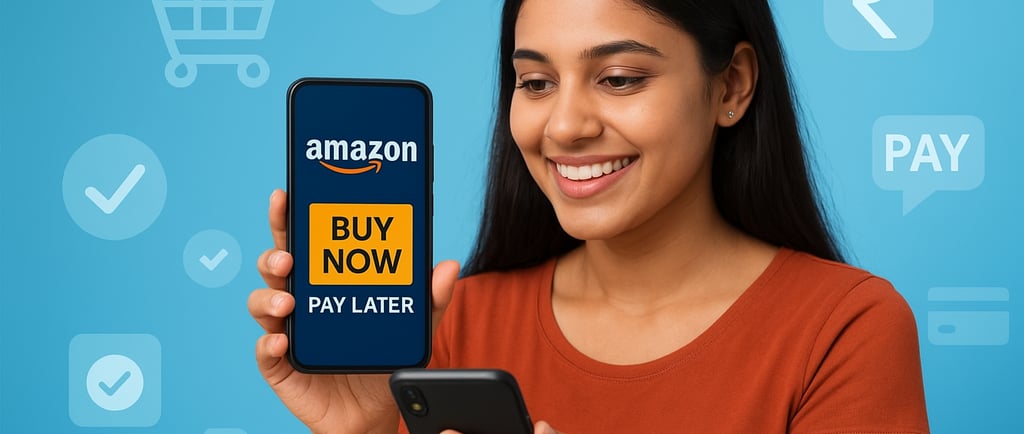Do You Know How “Buy Now, Pay Later” Fintech Is Transforming E-Commerce in India
Buy Now, Pay Later (BNPL) is transforming Indian e-commerce by making shopping more accessible, boosting sales for retailers, and providing flexible credit options to customers. This article explores how BNPL fintech is reshaping India’s digital economy with real examples, growth trends, and future opportunities.
BUSINESS & ECONOMY
Do You Know Team
8/31/20253 min read


The New Face of Indian Shopping
Imagine this: A college student in Delhi wants the latest smartphone but doesn’t have ₹30,000 upfront. A young professional in Bengaluru is eyeing a washing machine for her new flat but doesn’t want to exhaust her savings. A homemaker in Lucknow wants to buy a laptop for her child’s online classes but prefers installments. All of them now have a solution—Buy Now, Pay Later (BNPL). With just a few taps on apps like ZestMoney, Simpl, LazyPay, Amazon Pay Later, Flipkart Pay Later, or even Paytm Postpaid, Indians are experiencing a new way of shopping where credit is instant, interest-free (for a period), and hassle-free.
This is not just convenience—it’s a revolution in how India shops, borrows, and manages money online.
1. The Rise of BNPL in India: A Game-Changer in Digital Finance
BNPL fintech started gaining traction around 2019–2020 but exploded during the COVID-19 pandemic when people shifted heavily to e-commerce.
By 2025, India’s BNPL market is estimated to cross $15–20 billion, with millions of active users.
Unlike traditional credit cards, BNPL services don’t require long approval times, heavy documentation, or high credit scores.
📌 Live Example:
Amazon Pay Later has already enrolled over 10 million users in India.
Flipkart Pay Later sees over 3 million monthly transactions, showing consumer trust.
ZestMoney, once India’s biggest BNPL startup, partnered with brands like Myntra, MakeMyTrip, and Xiaomi to finance purchases ranging from ₹500 to ₹5 lakh.
2. Why Indians Love BNPL Over Credit Cards
Accessibility: Only 60 million Indians own a credit card, but BNPL fintech is available to 200+ million digital shoppers.
Small Ticket Sizes: Credit cards are seen as debt-heavy, but BNPL lets you finance even a ₹500 T-shirt.
Young Demographic: India’s Gen Z and millennials (18–35 years) are the largest adopters of BNPL, making up nearly 75% of users.
No Hidden Charges (if paid on time): Unlike credit cards with annual fees, BNPL often offers zero-cost EMI for short durations.
📌 Live Example:
A 25-year-old gamer in Pune bought a ₹60,000 gaming laptop using BNPL EMI on Flipkart—paying just ₹5,000 per month.
A homemaker in Jaipur purchased monthly groceries on Amazon Pay Later, with the bill cleared at month-end.
3. How BNPL Helps E-Commerce Giants Grow
Higher Sales Conversions: Retailers offering BNPL see 20–30% higher order completions.
Bigger Basket Size: Customers spend 40% more when BNPL is available.
Repeat Customers: Shoppers using BNPL return more frequently.
📌 Case Study:
Myntra saw a 25% rise in fashion sales after introducing BNPL.
MakeMyTrip added BNPL for flight bookings, leading to a surge in bookings from younger travelers.
4. The Dark Side: Risks and Challenges of BNPL
While BNPL looks like “free money,” it comes with challenges:
Debt Trap Risk: Many young users overspend, leading to missed payments.
Hidden Interest Beyond Free Period: After 30 days, some BNPL services charge 24–36% annual interest.
Credit Bureau Reporting: Defaults can harm CIBIL scores, impacting future loans.
📌 Real Incident:
In 2023, ZestMoney shut down operations after struggling with loan repayments, showing that the business model is still evolving in India.
5. RBI’s Role: Regulating BNPL in India
The Reserve Bank of India (RBI) has stepped in to:
Restrict NBFCs (non-banking finance companies) from reckless lending.
Ensure full disclosure of fees.
Mandate credit bureau reporting for BNPL loans.
This has slowed down some startups but improved consumer safety.
6. Future of BNPL in India – What’s Next?
Rural Adoption: With UPI + BNPL, even rural Indians will be able to finance essentials.
Integration with Credit Score: BNPL payments may become part of financial identity verification.
AI-Driven Risk Analysis: Fintech companies will use AI and machine learning to check repayment capacity instantly.
Partnerships with Big Tech: Expect Google Pay, PhonePe, and WhatsApp Pay to expand into BNPL soon.
📌 Live Example:
In 2025, PhonePe launched “PhonePe Postpaid Mini”, targeting rural customers with purchases as small as ₹50–500.
📌 FAQ Section
Q1. What is BNPL in India?
BNPL (Buy Now, Pay Later) lets consumers purchase goods/services instantly and pay in installments or at the end of the billing cycle.
Q2. Which BNPL apps are popular in India?
Amazon Pay Later, Flipkart Pay Later, ZestMoney, Simpl, LazyPay, Paytm Postpaid, and PhonePe Postpaid.
Q3. Is BNPL better than credit cards?
For small purchases, yes—it’s easier, faster, and requires less paperwork. But missing payments can be costlier than credit cards.
Q4. Can BNPL affect my CIBIL score?
Yes, defaults are reported to credit bureaus and can damage your credit score.
Q5. What is the future of BNPL in India?
Mass adoption in rural India, AI-driven credit risk management, and integration with UPI for seamless digital credit.
Conclusion: The Future of Shopping Is Credit-on-Demand
BNPL is not just a payment option—it’s the engine driving India’s e-commerce boom. With increasing internet penetration, youth-driven consumption, and fintech innovation, BNPL is becoming a mainstream credit tool. But as it grows, India must balance convenience with caution, ensuring users don’t fall into debt traps while enjoying financial freedom. In the coming years, BNPL could even replace credit cards in India, making it the most democratic credit revolution in history.
#BNPL #BuyNowPayLater #IndianEcommerce #FintechIndia #DigitalPayments #EcommerceTrends #RBI #FinancialFreedom #IndiaShoppingRevolution
Knowledge
Empowering minds with reliable educational content daily.
Newsletter Signup
© 2025 DoYouKnow. All rights reserved.
Stay Ahead of the Trends – Join Our Newsletter
